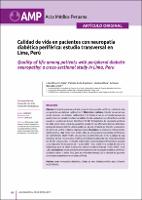Calidad de vida en pacientes con neuropatía diabética periférica: estudio transversal en Lima, Perú
Related Resource(s)
https://amp.cmp.org.pe/index.php/AMP/article/view/559Date
2018Author(s)
Oliveros-Lijap, Leila
Ávila-Espinoza, Pamela
Ulloa, Viviana
Bernabe-Ortiz, Antonio
Metadata
Show full item recordAlternate title
Quality of life among patients with peripheral diabetic
neuropathy: a cross-sectional study in Lima, Peru
Abstract
Objetivo: Evaluar la asociación entre la presencia de neuropatía periférica y calidad de vida
en pacientes con diabetes mellitus tipo 2. Materiales y métodos: Estudio transversal que
enroló pacientes con diabetes mellitus tipo 2, de 18 años a más en un hospital peruano de
nivel terciario. La variable resultado fue calidad de vida, evaluada en las esferas física y mental
usando el cuestionario 36-item Short Form (SF-36). El diagnóstico de neuropatía periférica
fue dado por al menos una de las siguientes: prueba del monofilamento Semmes-Weinstein,
prueba del diapasón 128 Hz, úlceras visibles en pie y/o artropatía de Charcot. La asociación
de interés se verificó mediante regresión lineal. Resultados: Se incluyeron 330 pacientes,
56,6% mujeres, edad media: 61,3 (±11,5) años. La prevalencia de neuropatía periférica fue
de 44,2% (IC95%: 38,8%–49,6%). De acuerdo a la esfera física del SF-36, la calidad de vida
media fue de 46,8 (±6,3) puntos; mientras, la media de la calidad de vida en la esfera mental
fue de 39,5 (±8,2) puntos. En modelo multivariable, la neuropatía periférica estuvo asociada
a una reducción de dos puntos (β = -2,06; IC95%: -3,52; -0,60) en la calidad de vida en la
esfera física, pero no afectó la calidad de vida en la esfera mental (β = 0,03; IC95%: -1,79;
1,85). Conclusiones: Existe asociación entre la presencia de neuropatía diabética periférica y
calidad de vida en la esfera física, pero no en la esfera mental. Casi la mitad de los pacientes
con diabetes presentaron neuropatía periférica. Objective: To assess the association between the presence of peripheral neuropathy and life quality among patients with
type 2 diabetes mellitus. Materials and methods: A cross-sectional study enrolling patients aged ≥18 years with diagnosis
of type 2 diabetes mellitus in a tertiary-level hospital. The outcome was quality of life, assessed in the physical and mental
spheres of the 36-item Short Form (SF-36). The diagnosis of peripheral neuropathy was given by the positivity of one of the
following tests: Semmes-Weinstein monofilament test, 128 Hz tuning fork test, presence of visible foot ulcers and/or Charcot
arthropathy. The linear regression model was used to verify the association of interest. Results: A total of 330 patients were
enrolled, 56.6% female, mean age 61.3 years (±11.5). The prevalence of peripheral neuropathy was 44.2% (95%CI: 38.8%–
49.6%). Based on the physical sphere of the SF-36, the mean of the quality of life was 46.8 (±6.3) points; whereas, the mean
of the quality of life in the mental sphere was 39.5 (±8.2). In multivariable model, peripheral neuropathy was associated with
a reduction of 2 points (β = -2.06; IC95%: -3.52; -0.60) in the physical sphere of the quality of life score, but it did not change
the mental sphere (β = 0.03; IC95%: -1.79; 1.85). Conclusions: The peripheral neuropathy among type 2 diabetes cases was
associated with reduction of quality of life in the physical sphere, but not in the mental one. Almost half of diabetes patients
had peripheral neuropathy.
Collections
- Artículos científicos [890]






